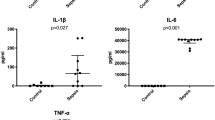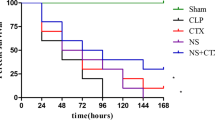Abstract
Objective
To investigate the early effects of hypertonic and isotonic saline solutions on apoptosis of intestinal mucosa in rats with hemorrhagic shock.
Methods
A model of rat with severe hemorrhagic shock was established in 21 Sprague-Dawley (SD) rats. The rats were randomly divided into the sham group, normal saline resuscitation (NS) group, and hypertonic saline resuscitation (HTS) group, with 7 in each group. We detected and compared the apoptosis in small intestinal mucosa of rats after hemorrhagic shock and resuscitation by terminal deoxynucleotidyl transferase dUTP nick end labelling (TUNEL), FITC (fluorescein-iso-thiocyanate)-Annexin V/PI (propidium iodide) double staining method, and flow cytometry.
Results
In the early stage of hemorrhagic shock and resuscitation, marked apoptosis of small intestinal mucosa in the rats of both NS and HTS groups was observed. The numbers of apoptotic cells in these two groups were significantly greater than that in the sham group (P<0.01). In the HTS group, the apoptic cells significantly decreased, compared with the NS group (P<0.01).
Conclusion
In this rat model of severe hemorrhagic shock, the HTS resuscitation of small volume is more effective than the NS resuscitation in reducing apoptosis of intestinal mucosa in rats, which may improve the prognosis of trauma.
Similar content being viewed by others
References
Attuwaybi, B., Kozar, R.A., Gates, K.S., Moore-Olufemi, S., Sato, N., Weisbrodt, N.W., Moore, F.A., 2004. Hypertonic saline prevents inflammation, injury, and impaired intestinal transit after gut ischemia/reperfusion by inducing heme oxygenase 1 enzyme. J. Trauma, 56(4): 749–758.
Bellamy, R.F., 1984. The causes of death in conventional land warfare: implications for combat casualty care research. Mil. Med., 149(2):55–62.
Bulger, E.M., Cuschieri, J., Warner, K., Maier, R.V., 2007. Hypertonic resuscitation modulates the inflammatory response in patients with traumatic hemorrhagic shock. Ann. Surg., 245(4):635–641. [doi:10.1097/01.sla.000025 1367.44890.ae]
Bulger, E.M., Jurkovich, G.J., Nathens, A.B., Copass, M.K., Hanson, S., Cooper, C., Liu, P.Y., Neff, M., Awan, A.B., Warner, K., Maier, R.V., 2008. Hypertonic resuscitation of hypovolemic shock after blunt trauma: a randomized controlled trial. Arch. Surg., 143(2):139–148. [doi:10.1001/archsurg.2007.41]
Cai, X.J., Huang, D.Y., Mu, Y.P., Peng, S.Y., 2002. Hypertonic saline solution resuscitation in hemorrhagic shock dog. Chin. J. Traumatol., 5(3):180–185.
Capone, A.C., Safar, P., Stezoski, W., Tisherman, S., Peitzman, A.B., 1995. Improved outcome with fluid restriction in treatment of uncontrolled hemorrhagic shock. J. Am. Coll. Surg., 180(1):49–56.
Cruz, R.J.Jr., Yada-Langui, M.M., de Figueiredo, L.F., Sinosaki, S., Rocha-e-Silva, M., 2006. The synergistic effects of pentoxifylline on systemic and regional perfusion after hemorrhage and hypertonic resuscitation. Anesth. Analg., 102(5):1518–1524. [doi:10.1213/01.ane.0000204255.35494.f2]
Dantzker, D.R., 1993. The gastrointestinal tract. The canary of the body? JAMA, 270(10):1247–1248. [doi:10.1001/jama.270.10.1247]
Diebel, L.N., Liberati, D.M., Baylor, A.E.3rd, Brown, W.J., Diglio, C.A., 2005. The pivotal role of tumor necrosis factor-alpha in signaling apoptosis in intestinal epithelial cells under shock conditions. J. Trauma, 58(5):995–1001.
Gonzalez, E.A., Kozar, R.A., Suliburk, J.W., Weisbrodt, N.W., Mercer, D.W., Moore, F.A., 2006. Conventional dose hypertonic saline provides optimal gut protection and limits remote organ injury after gut ischemia reperfusion. J. Trauma, 61(1):66–73.
Homma, H., Deitch, E.A., Feketeova, E., Lu, Q., Berezina, T.L., Zaets, S.B., Machiedo, G.W., Xu, D.Z., 2005. Small volume resuscitation with hypertonic saline is more effective in ameliorating trauma-hemorrhagic shock-induced lung injury, neutrophil activation and red blood cell dysfunction than pancreatitic protease inhibition. J. Trauma, 59(2):266–272.
Hoppen, R.A., Corso, C.O., Grezzana, T.J., Severino, A., Dal-Pizzol, F., Ritter, C., 2005. Hypertonic saline and hemorrhagic shock: hepatocellular function and integrity after six hours of treatment. Acta Cir. Bras., 20(6): 414–417. [doi:10.1590/S0102-86502005000600003]
Hotchkiss, R.S., Schmieg, R.E.Jr., Swanson, P.E., Freeman, B.D., Tinsley, K.W., Cobb, J.P., Karl, I.E., Buchman, T.G., 2000. Rapid onset of intestinal epithelial and lymphocyte apoptotic cell death in patients with trauma and shock. Crit. Care Med., 28(9):3207–3217. [doi:10.1097/00003246-200009000-00016]
Hoyt, D.B., 2004. A clinical review of bleeding dilemmas in trauma. Semin. Hematol., 41(1 Suppl. 1):40–43. [doi:10.1053/j.seminhematol.2003.11.009]
Lu, Y.Q., Cai, X.J., Gu, L.H., Fan, Y.J., Wang, Q., Bao, D.G., 2005. Effects of three fluid resuscitation methods on apoptosis of visceral organs in rats with hemorrhagic shock. J. Zhejiang Univ. Sci. B, 6(9):907–912. [doi:10.1631/jzus.2005.B0907]
Lu, Y.Q., Cai, X.J., Gu, L.H., Wang, Q., Huang, W.D., Bao, D.G., 2006. Early difference in apoptosis of intestinal mucosa of rats with severe uncontrolled hemorrhagic shock after three fluid resuscitation methods. Chin. Med. J., 119(10):858–863.
Lu, Y.Q., Cai, X.J., Gu, L.H., Wang, Q., Huang, W.D., Bao, D.G., 2007a. Experimental study of controlled fluid resuscitation in the treatment of severe and uncontrolled hemorrhagic shock. J. Trauma, 63(4):798–804.
Lu, Y.Q., Cai, X.J., Gu, L.H., Mu, H.Z., Huang, W.D., 2007b. Hypertonic saline resuscitation maintains a more balanced profile of T-lymphocyte subpopulations in a rat model of hemorrhagic shock. J. Zhejiang Univ. Sci. B, 8(1):70–75. [doi:10.1631/jzus.2007.B0070]
Moore, F.A., McKinley, B.A., Moore, E.E., 2004. The next generation in shock resuscitation. Lancet, 363(9425): 1988–1996. [doi:10.1016/S0140-6736(04)16415-5]
Murao, Y., Hata, M., Ohnishi, K., Okuchi, K., Nakajima, Y., Hiasa, Y., Junger, W.G., Hoyt, D.B., Ohnishi, T., 2003. Hypertonic saline resuscitation reduces apoptosis and tissue damage of the small intestine in a mouse model of hemorrhagic shock. Shock, 20(1):23–28. [doi:10.1097/01.shk.0000078832.57685.6c]
Ozgüç, H., Tokyay, R., Kahveci, N., Serdar, Z., Gür, E.S., 2003. Hypertonic saline dextran alleviates hepatic injury in hypovolemic rats undergoing porta hepatis occlusion. Shock, 19(4):383–387. [doi:10.1097/00024382-200304000-00015]
Powers, K.A., Zurawska, J., Szaszi, K., Khadaroo, R.G., Kapus, A., Rotstein, O.D., 2005. Hypertonic resuscitation of hemorrhagic shock prevents alveolar macrophage activation by preventing systemic oxidative stress due to gut ischemia/reperfusion. Surgery, 137(1):66–74. [doi:10.1016/j.surg.2004.05.051]
Rhee, P., Wang, D., Ruff, P., Austin, B., DeBraux, S., Wolcott, K., Burris, D., Ling, G., Sun, L., 2000. Human neutrophil activation and increased adhesion by various resuscitation fluids. Crit. Care Med., 28(1):74–78. [doi:10.1097/00003246-200001000-00012]
Rizoli, S.B., Rhind, S.G., Shek, P.N., Inaba, K., Filips, D., Tien, H., Brenneman, F., Rotstein, O., 2006. The immunomodulatory effects of hypertonic saline resuscitation in patients sustaining traumatic hemorrhagic shock: a randomized, controlled, double-blinded trial. Ann. Surg., 243(1):47–57. [doi:10.1097/01.sla.0000193608.93127.b1]
Rocha-e-Silva, M., Negraes, G.A., Soares, A.M., Pontieri, V., Loppnow, L., 1986. Hypertonic resuscitation from severe hemorrhagic shock: pattern of regional circulation. Circ. Shock, 19(2):165–175.
Schmieg, R.E.Jr., Tinsley, K.W., Swanson, P.E., Karl, I.E., Aft, R., Buchman, T.G., Hotchkiss, R.S., 2000. Rapid onset of hepatocyte apoptosis in a patient with trauma. J. Trauma, 49(3):542–546.
Shires, G.T., Browder, L.K., Steljes, T.P., Williams, S.J., Browder, T.D., Barber, A.E., 2005. The effect of shock resuscitation fluids on apoptosis. Am. J. Surg., 189(1): 85–91. [doi:10.1016/j.amjsurg.2004.06.040]
Vajda, K., Szabó, A., Boros, M., 2004. Heterogeneous microcirculation in the rat small intestine during hemorrhagic shock: quantification of the effects of hypertonic-hyperoncotic resuscitation. Eur. Surg. Res., 36(6): 338–344. [doi:10.1159/000081640]
van Way, C.W.3rd, Dhar, A., Morrison, D., 2003. Hemorrahagic shock: a new look at an old problem. Mol. Med., 100(5):518–523.
Victorino, G.P., Newton, C.R., Curran, B., 2003. Effect of hypertonic saline on microvascular permeability in the activated endothelium. J. Surg. Res., 112(1):79–83. [doi: 10.1016/S0022-4804(03)00132-X]
Wu, B., Ootani, A., Iwakiri, R., Fujise, T., Tsunada, S., Toda, S., Fujimoto, K., 2004. Ischemic preconditioning attenuates ischemia-reperfusion-induced mucosal apoptosis by inhibiting the mitochondria-dependent pathway in rat small intestine. Am. J. Physiol. Gastrointest. Liver Physiol., 286(4):580–587. [doi:10.1152/ajpgi.00335.2003]
Xu, Y.X., Ayala, A., Monfils, B., Cioffi, W.G., Chaudry, I.H., 1997. Mechanism of intestinal mucosal immune dysfunction following trauma-hemorrhage: increased apoptosis associated with elevated Fas expression in Peyer’s patches. J. Surg. Res., 70(1):55–60. [doi:10.1006/jsre.1997.5111]
Yu, Z.Y., Ono, S., Spatz, M., McCarron, R.M., 2002. Effect of hemorrhagic shock on apoptosis and energy-dependent efflux system in the brain. Neurochem. Res., 27(12): 1625–1632. [doi:10.1023/A:1021630926302]
Zakaria, E.R., Tsakadze, N.L., Garrison, R.N., 2006. Hypertonic saline resuscitation improves intestinal microcirculation in a rat model of hemorrhagic shock. Surgery, 140(4):579–587. [doi:10.1016/j.surg.2006.05.015]
Zhang, C., Sheng, Z.Y., Hu, S., Gao, J.C., Li, J.Y., Liu, Y., 2004. The role of oxygen-free radical in the apoptosis of enterocytes in scalded rats after delayed resuscitation. J. Trauma, 56(3):611–617.
Zhao, J., Schmid-Kotsas, A., Gross, H.J., Gruenert, A., Bachem, M.G., 2003. Sensitivity and specificity of different staining methods to monitor apoptosis induced by oxidative stress in adherent cells. Chin. Med. J., 116(12):1923–1929.
Author information
Authors and Affiliations
Corresponding author
Additional information
Project (No. 20061420) supported by the Education and Research Foundation of Zhejiang Province, China
Rights and permissions
About this article
Cite this article
Lu, Yq., Huang, Wd., Cai, Xj. et al. Hypertonic saline resuscitation reduces apoptosis of intestinal mucosa in a rat model of hemorrhagic shock. J. Zhejiang Univ. Sci. B 9, 879–884 (2008). https://doi.org/10.1631/jzus.B0820116
Received:
Accepted:
Published:
Issue Date:
DOI: https://doi.org/10.1631/jzus.B0820116
Key words
- Hemorrhagic shock
- Resuscitation
- Sodium chloride solution
- Hypertonic saline
- Apoptosis
- Intestinal mucosa
- Flow cytometry
- In situ nick-end labelling




